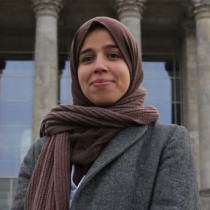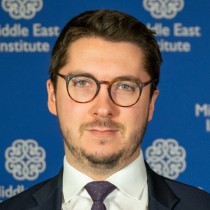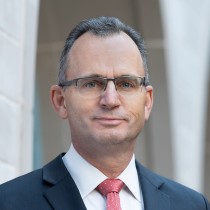Contents:
- Tragic earthquake highlights the "two Moroccos"
- The state of al-Qaeda and terrorist activity inside Afghanistan
- New perspective on Iran calls for new policies
- Mediterranean Storm Daniel reveals climate vulnerability and urgent need for preparedness
- The Biden administration’s painful silence on Syria
- Biden’s proactive Middle East diplomacy bears some fruit
- The Abraham Accords three years on: Part of the new game but not a game changer
Tragic earthquake highlights the “two Moroccos”
Intissar Fakir
Senior Fellow and Director of Program on North Africa and the Sahel

-
Friday night’s deadly earthquake showcased two of the country’s persistent issues: the disparity of development between rural and urban areas, and the bottlenecking inherent in a powerful top-heavy decision-making process.
-
For a crisis that requires fast, decisive action, the government has been caught on its backfoot — a consequence of the structural features of Morocco’s political system, dominated by the monarchy and hostile to the bureaucracy taking initiative.
The devastating Friday night earthquake that hit Morocco’s High Atlas region killing thousands once again showcased two of the country’s persistent issues: the disparity of development between rural and urban areas, and the bottlenecking inherent in a powerful top-heavy decision-making process.
The first issue is but the latest chapter in an old tale of two Moroccos. Back in pre-colonial times, the sultanate saw its lands as either Bilad al-Makhzen or Bilad al-Siba — the “governed” area of under the sultan’s control versus the “region of anarchy,” respectively. Later, the French colonial administration explicitly divided Morocco into le Maroc utile and inutile (“useful” and “useless” Morocco). In both cases, the difference denoted the perimeter at which government services and control ended, with the areas outside of this zone tacitly under state control but generally neglected. That pattern has carried on to the present. Today just outside of Marrakesh — Morocco’s touristic face to much of the rest of the world — large swathes of the population struggle with deep poverty as they have for decades, with limited access to basic services, including hospitals, schools, sanitation, running water, or electricity. These areas generally escaped bureaucratic oversight; and with little political agency or economic resources, the villages have developed slowly and haphazardly.
The extent to which the impoverished and neglected areas have been deprioritized stems from a political choice maintained over decades. Rightly or not, Morocco’s government opted to put most of its resources into areas and communities deemed to deliver the greatest economic returns — namely, coastal zones with large populations. As such, infrastructural development focused on linking nodes of high production to areas that facilitate easier access for shipping and transit, allowing for greater integration of Moroccan industry with global or regional value chains. The High Atlas is a world away from this economic strategy. While the leadership is aware of the persistent duality the policy has wrought on the country, real efforts to address the socio-economic fissures have either lagged or gone unimplemented. An element contributing to the de-prioritization of some areas has been the lack of strong political pressure: For example, unlike the Rif region, which saw sustained protests in 2016 that helped draw political and bureaucratic attention and eventually mobilize development there, the Haouz region has lacked any persistent protests or stronger political advocacy to draw the government’s gaze and focus state resources and services. This in part explains the disproportionate impact of last weekend’s unusually strong earthquake. It also highlights the challenges facing current rescue operations, which must navigate the area’s remoteness and lack of effective connectivity and infrastructure.
Another major issue that has already drawn local anger and increasing international concern has been the government’s silence and sluggishness in responding to the earthquake. For a crisis that requires fast, decisive action, the government has been caught on its backfoot — a consequence of the structural features of Morocco’s political system. First is the extent to which the monarchy dominates decision-making, rendering action and ownership by other governmental institutions difficult. All must defer to the king and await his directives. Not only is this heavy centralized power structure creating a bottleneck to rescue and relief efforts, but it is also compounded by the tradition of tightly controlled optics around the king and royal family. A general lack of political agency and ownership outside of the monarchy slows the decision-making progress further, adding another layer of delays and increasing anger, while overshadowing the work currently done by various state institutions that would actually be able to capitalize on their own sound planning. None of their efforts will be effective or visible within a political context dominated by fears of stepping up.
Yet every crisis holds a glimmer of potential. And Morocco can rebuild. Even inside the smallest of villages, the extent of communal support and solidarity currently on display between local residents, civil society, the diaspora, and international and regional partners could be key to building back a stronger and better served rural community.
Follow on Twitter: @IntissarFakir
The state of al-Qaeda and terrorist activity inside Afghanistan
David Wells
Contributor
-
Even prior to its leader’s death, al-Qaeda was struggling for relevance in an increasingly de-centralized jihadist landscape driven by locally focused and controlled affiliates, far removed in ideology and strategy from the aging core leadership.
-
The greater terrorist threat emerging from Afghanistan remains the Taliban’s bitter enemy, ISKP, which has significantly more fighters and resources than al-Qaeda and has demonstrated its intent and capability to conduct complex attacks in Afghanistan and neighboring countries.
The 22nd anniversary of the 9/11 attacks offers an opportunity to re-evaluate the current threat posed by its perpetrator, al-Qaeda. If last Friday’s anonymous briefing to CNN by two American officials is to be believed, the picture is rosy. New U.S. intelligence assessments reportedly concluded that the threat from al-Qaeda is “at its lowest point in decades,” with the group at its “historical nadir” in Afghanistan and Pakistan.
There is some evidence to support such an optimistic outlook. Al-Qaeda is yet to announce a successor to Ayman al-Zawahiri, more than one year since he was killed in a U.S. drone strike. And even prior to his death, the organization was struggling for relevance in an increasingly decentralized jihadist landscape driven by locally focused and controlled affiliates, far removed in ideology and strategy from al-Qaeda’s aging core leadership.
An alternate, altogether less positive perspective was presented by a June 2023 United Nations report, which argued that although al-Qaeda was maintaining a low profile, it was using Afghanistan as a hub to mobilize and recruit new fighters while covertly rebuilding its external operations capacity.
This is certainly worrying if true, as the past three decades have shown the risks posed by terrorist safe havens, particularly those like Afghanistan, which today is awash in weapons and abandoned Western military equipment. However, significant strategic questions remain for al-Qaeda’s new leader (whoever he may be). It remains an aging organization — depleted by two decades of drone strikes — with no recent examples of successfully planning and conducting attacks outside of Afghanistan and a narrative that appears ill-suited to the jihadist environment in 2023. Meanwhile in Africa, al-Qaeda’s affiliates Jama’at Nasr al-Islam wal Muslimin (JNIM) and al-Shabaab continue to flourish, seemingly in the absence of meaningful guidance or resources from its Afghanistan-based “leadership.”
As yet, the greater terrorist threat emerging from Afghanistan remains the Taliban’s bitter enemy, the Islamic State – Khorasan Province (ISKP). It has significantly more fighters and resources than al-Qaeda and has demonstrated its intent and capability to conduct complex attacks in Afghanistan (before and after the Taliban takeover) as well as in neighboring countries (including a major attack in Pakistan in July). To what extent the Taliban can curtail ISKP’s external ambitions is currently likely to be the biggest determining factor in Afghanistan’s impact on the global terrorist threat.
Follow on Twitter: @DavidWellsCT
New perspective on Iran calls for new policies
Marjan Keypour
Non-Resident Scholar

-
The media coverage of the protests that erupted in response to the murder of Mahsa Amini reawakened the world to the reality of human rights violations in Iran.
-
Having lost hope in their government, many Iranian people continue to risk everything to fight for their freedom and dignity.
The murder of Mahsa Amini in September 2022 awakened the world to the harsh reality that Iranian women have endured for decades. What were once seen as cultural or religious preferences or domestic matters inside Iran have now been revealed as systematic repression and degradation. Amini’s killing by the so-called “morality police” exposed the vulnerability of all segments of society and alarmed the majority that they too could become targets of the regime's arbitrary system. These internal and external pressures have pushed Iran toward a tipping point.
In the past year, nearly 700 men, women, and children protesting the regime and its policies have been killed. Many were shot by the authorities as part of crackdowns on demonstrations, others were tortured to death or executed; even some bystanders became victims. The violence heightened global awareness and solidarity with the Iranian people and their plight. Even amid a lull in the protest movement, the Iranian people’s struggle continued to draw global attention, perhaps due to worries about the apparent parallels with what has been happening in Afghanistan. The many atrocities in Iran remain undisclosed, however, and the representatives of the Iranian government who censor the media and block the internet are not reliable narrators of their citizens' condition.
The sheer scale of last year’s protests, combined with the widespread solidarity abroad, emboldened the Iranian people to once more showcase their bravery against the regime’s arbitrary laws — most visibly by defying the hijab mandate. But this courage comes at a great cost. Not only did the regime not abolish the morality police, it enhanced punishments, sexually assaulted prisoners in its custody, and curtailed civil rights to anyone unwilling to accept the government’s mandates on “modesty.” Nonetheless, the collective power of protests in all forms continues and might gain new momentum as we approach the anniversary.
The regime not only disregarded the people’s basic demands for freedom and dignity but has also neglected their essential needs. Growing rates of hunger, poverty, unemployment, and environmental degradation have devastated Iranians’ quality of life over the past year. Even citizens who had not necessarily participated in the Mahsa Amini demonstrations are finding reasons to join new protests and to agitate against the government. This includes retirees who haven’t received their pensions, new parents who can’t find baby formula, and others suffering from regular blackouts. Poverty has exacerbated the sense of injustice throughout Iranian society, which officials are finding extremely difficult to quell.
The amplification of these failures and frustrations both at home and abroad has eroded the regime’s legitimacy. Iranian officials who are on shaky ground fear hacking scandals on the one hand and their replacement with loyalists on the other, all the while facing sanctions and visa restrictions from foreign governments. Both the regime’s attempts at marginal reform and its return to hardline policies have run their course. New economic deals with China, Russia, Saudi Arabia, and the United Arab Emirates might buy it some time but not acceptance in the eyes of tens of millions of Iranians.
Last year, the world opened its eyes and hearts to the Iranian people; and today, with the Iranian regime still unrepentant and maintaining its crackdown, international leaders have a moral decision before them — complicity or action.
Follow on Twitter: @MarjanKG
Mediterranean Storm Daniel reveals climate vulnerability and urgent need for preparedness
Malak Altaeb
Non-Resident Scholar

-
The impact of Storm Daniel in Libya underscores the vulnerability of coastal regions to extreme weather events exacerbated by climate change.
-
The event also revealed the lack of prepared adaptation and mitigation plans in North African countries.
Over the weekend, Mediterranean Storm Daniel hit the eastern region of Libya, causing material losses and power cuts as well as at least 150 deaths, according to one official, with scores drowning as they were washed away by floods. Authorities in Libya announced a state of emergency and imposed curfews in response to the storm. The government additionally declared the city of Darna, in eastern Libya, a disaster zone.
Daniel’s devastating impact and ripple effects across the region offer a sobering reflection on the growing climate urgency faced by Mediterranean Sea littoral countries and, in particular, those located in North Africa. Although the storm was forecasted to arrive in Libya after it hit Greece, local and national authorities implemented almost no pre-storm measures or pre-evacuation plans in the targeted region, highlighting the urgent need for comprehensive disaster preparedness and resilient infrastructure.
The disaster additionally underscores the vulnerability of all coastal zones to extreme weather events exacerbated by climate change. Rising sea levels, unpredictable weather patterns, and intense storms threaten lives, property, and critical infrastructure along these coastlines. And Daniel revealed the particular lack of readiness of countries in North Africa, which have no prepared adaptation and mitigation plans to deal with extreme weather events. Finally, the storm’s trajectory, from Greece, Bulgaria, and Turkey to Libya, illustrated how climate-related events know no borders. Collaborative efforts at the regional and international levels will, thus, be crucial to managing and mitigating these crises going forward.
The catastrophic aftermath of Mediterranean Storm Daniel in Libya and its impact on the surrounding regions has demonstrated yet again the reality that climate change is a global crisis with far-reaching and immediate repercussions. It is essential to act swiftly at all levels — local, national, and international — to confront this environmental emergency, enhance resilience, and protect vulnerable communities from extreme weather conditions.
Follow on Twitter: @MalakLibya1
The Biden administration’s painful silence on Syria
Charles Lister
Senior Fellow, Director of Syria and Countering Terrorism & Extremism programs

-
Since April, Syria has witnessed the most potentially consequential developments in years, including some that directly challenge U.S. interests, but the Biden administration and the U.S. government at large have remained silent.
-
Two-and-a-half years into the Biden administration, a combination of inaction, indifference, and silence has considerably weakened U.S. interests in what remains one of the world’s most acute geopolitical battlegrounds.
“Ultimately, the only solution to the crisis inflicted on Syria by [Bashar al-]Assad has to be consistent with the [United Nations] Security Council Resolution 2254, that lays out expectations for a ceasefire, for humanitarian assistance and free and fair elections to ensure that Syrians have a government that actually reflects the will of the Syrian people. We agree on the importance — the imperative — of expanding humanitarian access to Syria. We agree on the importance of continuing the work to degrade ISIS or Daesh, to make sure that it can’t re-emerge.”
These were the words of Secretary of State Antony Blinken four months ago. Two months later, President Joe Biden reportedly told a private audience that he “agreed” Assad must go. Yet despite these assertive words, the Biden administration and the U.S. Government at large have remained painfully silent on Syria in recent months. Were the situation in Syria relatively stable, the administration’s hands-off containment policy might pass by largely unnoticed, but since April, the country has witnessed some of the most potentially consequential developments in years — some that directly challenge U.S. interests and others that offer strategically invaluable opportunities to move toward realizing what the administration says it seeks to achieve.
Since President Biden took office, the one element of Syria policy that his administration has visibly committed to is humanitarian aid access. Secretary Blinken has traveled to speak on the issue at the U.N. Security Council, staking a claim of responsibility upon it. Yet in July, Russia used its Security Council veto to sever the last remaining route to supply aid into northern Syria, in a brazen challenge to long-standing U.S.-led international policy. In the weeks that followed, the U.N. caved in to accept an offer by Assad to allow aid to move, provided he controls the process. Since then, aid flows have collapsed, dropping by roughly 85% — to a region considered to be the world’s most acute humanitarian crisis. Not a word from the administration since.
Meanwhile, within weeks of regional states re-engaging Assad and allowing Syria to rejoin the Arab League, its economy has collapsed, subsidies have been pulled, and Syrians have taken back to the streets in regime-held areas — in a way unseen for years, if not since the start of the uprising in 2011. The beating heart of this new protest movement is the Druze province of Sweida, where men, women, and children have now been demanding Assad’s downfall for 23 days. Neighboring Daraa — also controlled by the regime — has joined in unity, triggering protests in every corner of the country. Adding to this profound sense of uncertainty, small demonstrations, anti-regime graffiti, and localized clashes with security forces have occurred in regime-held Aleppo, Homs, and Hama governorates, along with unprecedented public expressions of anger at Assad from within his Alawite community. Every act of organized protest has demanded Assad’s departure and the implementation of UNSCR 2254, but not a word from the Biden administration.
Most recently, a tribal uprising in eastern Syria’s Deir ez-Zor, against America’s partner in the fight against ISIS, the Syrian Democratic Forces (SDF), has barely registered in policymaking circles. Over 200 people were killed in a week of fighting, as almost all tribal groupings defected and formed a new armed tribal coalition demanding their own, separate relationship with the U.S.-led Operation Inherent Resolve. The underlying root cause and drivers for this conflict run deep and have never been taken seriously enough and while the SDF claims to have quelled the uprising, successive arrest campaigns since suggest it is far from over. That prospect will empower ISIS, weaken the SDF, and almost certainly pave an unpredictable path toward an Afghanistan-style withdrawal from Syria. But again, silence from the administration.
Two months before Biden won the presidency, Blinken said fixing the mistakes made in Syria during the Obama administration was “something we will need to act on.” Yet two-and-a-half years in, a combination of inaction, indifference, and silence has considerably weakened U.S. interests in what remains one of the world’s most acute geopolitical battlegrounds. If great power competition were such a priority, Syria would deserve far greater attention.
Follow on Twitter: @Charles_Lister
Biden’s proactive Middle East diplomacy bears some fruit
Brian Katulis
Vice President of Policy

-
A new effort to advance regional integration is unveiled the same week that the Biden team seeks to set the conditions for a possible deal between Israel and Saudi Arabia.
-
Putting more of an emphasis on opportunities for greater regional security and prosperity is important to unlock new economic potential; but these regional integration plans can’t ignore the tough realities of a region that continues to have big pockets of insecurity, particularly in poorer countries with less stable governance.
U.S. President Joe Biden traveled overseas this past week for the G20 summit in New Delhi, where the focus was on India’s efforts to expand its role in global diplomacy and the international debate over Russia’s war against Ukraine. But the Middle East featured prominently at this G20, with a new commitment by several countries to establish a major international infrastructure initiative, the India-Middle East-Europe Economic Corridor (IMEC).
Biden called IMEC “a real big deal” and said it would lead to a more stable, prosperous, and integrated Middle East. The theme of regional integration is one at the core of Biden’s approach in the Middle East, articulated by the president during his visit to Saudi Arabia in July 2022, when he sent the core message that, “The United States is invested in building a positive future in the region, in partnership with all of you, and the United States is not going anywhere.”
The background basics on IMEC include:
A commitment from Saudi Arabia, the United Arab Emirates, India, the European Union, Italy, Germany, and the United States to work together to create an interconnected network of railways and ports to facilitate trade, expand access to clean energy, and enhance secure and stable digital connectivity across the region.
The main idea is to help the broader Middle East move from being an “arc of crisis” to a more stable, integrated bridge between Asia and Europe.
The hope is to boost economic growth within the region by building networks that facilitate trade and spark job creation.
Like similar “big concept” projects, IMEC is a notion that will require a lot of detailed work on implementation. The communique announcing the initiative itself uses the verb “intend” several times to describe what the participants will do. But the concept is the product of ongoing mini-lateral discussions within various groupings, including the I2U2 (India, Israel, the UAE, and the U.S.) analyzed by MEI scholar Mohammed Soliman last year. In a region dominated by many human security problems, it is encouraging to see time and attention devoted to creating new opportunities.
While President Biden was focused on global dynamics, key members of his team traveled to Saudi Arabia to hold discussions with counterparts on a range of issues, including the Yemen conflict and efforts to advance a possible deal to normalize ties between Saudi Arabia and Israel. These talks didn’t appear to produce any immediate major breakthroughs, but the visit represents the sort of ongoing, steady diplomacy that is needed to build a framework for possible breakthroughs down the road.
In trying to advance a more proactive, “long game” diplomacy that produced greater regional integration, however, the Biden team cannot avoid addressing the weak points in the region, the pockets of instability, poverty, and poor governance that continue to plague the Middle East in places like Iran, Yemen, Iraq, Syria, Lebanon, and Palestine. As The Economist magazine recently noted, “The success stories, the Gulf and Israel, account for only 14% of the population but 60% of GDP, 73% of goods exports, and 75% of inward multinational investment.” In today’s Middle East, the gap between the haves and the have nots remains considerable, and dreams of regional integration can easily blow up if key segments of the population aren’t included.
The Biden administration has wisely ignored the calls from some inside of America to retreat from the region and instead has stepped up its engagement at a time when other priorities at home and in the world loom large. As it moves forward with implementing proactive plans like the IMEC announced last week, it should leave space on its crowded agenda to work with the people of the region, who are too often overlooked as part of solutions for the future.
Follow on Twitter: @Katulis
The Abraham Accords three years on: Part of the new game but not a game changer
Paul Salem
President and CEO

-
The Abraham Accords are an important element of the emerging landscape of the Middle East and part of a broader trend of de-escalation and normalization of relations.
-
The Israeli-Palestinian conflict, which remains one of the core tensions within the region, was only made more volatile by the Accords, underscoring the pressing need for progress on that front as part of any future regional normalization.
The Abraham Accords, signed three years ago this week, have become an important part of a changing regional landscape, although their impact should not be overestimated.
The regional tectonic plates had been shifting for several years before the Abraham Accords were formally signed in September 2020, and most of the countries involved had maintained quiet ties with Israel for many years previous. Part of this shift was a result of Israel’s changed external threat perception: For most of the 20th century, it had feared Arab states, but that had shifted to concerns about Iran and groups that it supported, especially Hezbollah. Among the Arab states, the main threat perceptions had also shifted, from Israel to Iran.
The Accords might have been expected to firmly realign the region, with a hardened and U.S.-backed axis lined up against Iran and its allies. To the contrary, as the Gulf states normalized (or are negotiating to normalize) relations with Israel, they have de-escalated and normalized relations with Iran and its Syrian ally, Bashar al-Assad. This normalization has also extended to Saudi Arabia’s previous arch-foe, Turkey’s Recep Tayyip Erdoğan.
The Accords were a signal foreign policy achievement of the Trump administration, and the Biden administration is now scrambling to make a similar breakthrough between Saudi Arabia and Israel. While such U.S.-brokered breakthroughs strengthen American influence and leverage in the Middle East, they haven’t led to a sea change. In this period, Saudi Arabia turned to China for a major normalization agreement with Iran, China’s relations in the Middle East continued to grow, U.S. partners in the region did not back Washington's tough stance against Russia’s invasion of Ukraine, and energy deals with Moscow continued apace.
Interestingly, the Accords did not elicit any major Iranian backlash. Indeed, Iran normalized its relations with Saudi Arabia, the UAE, and others during this period. Equally important, Hezbollah effectively entered into a U.S.-brokered Lebanon-Israel maritime border agreement to allow both countries to extract offshore gas.
It is important to note that Israel and its Accord partners now have very divergent approaches vis-à-vis Iran. While Iran remains a worry to all, the Gulf countries in particular have normalized relations with Tehran and sought to maintain a neutral position with regard to any future conflict between Israel and Iran, whereas Israel might have hoped that its new partners would cleave closer to its own position.
All parties have benefited from increased trade and investment — trade among Accord countries totaled an estimated $3.37 billion through the end of 2022 — as well as increased tourism. The opening of the Abrahamic Family House in Abu Dhabi, which accompanied the Accords, helped delink Israeli-Palestinian or Israeli-Arab hostility from the question of religious tolerance and respect between Muslims and Jews. This goes along with the UAE’s previous efforts to bring together the grand mufti of al-Azhar and the Catholic pope to work toward reinforcing Muslim-Christian religious tolerance and respect.
The Palestinians were the biggest losers in these Accords, as the previous “land for peace” approach was jettisoned for something closer to Israeli Prime Minister Benjamin Netanyahu’s “peace for peace” or “temporary suspension of annexation for peace.” Sudan was removed from the U.S. state sponsors of terrorism list, Morocco won U.S. recognition of its sovereignty over the Western Sahara, and Bahrain gained improved long-term relations with Washington. For its part, the UAE was counting on a positive turnaround in its relations with the U.S. and the securing of F-35 fighter jets; but this, so far, has not materialized.
Israel might have been expected to be the biggest winner from the Accords, but three years later, it is in dire straits of its own, with its internal cohesion collapsing and its domination of the Palestinians becoming more blatantly aggressive and apartheid-like. Of course, many of the dynamics in Israel have nothing to do with the Accords, but one cannot help but wonder what the impact of hubris might have been. With no pushback from the U.S. over the past decades, and now no pushback from the key Arab states, Israel’s right wing has charged even further ahead, risking both an Israeli-Palestinian civil war as well as an intra-Israeli breakdown.
Three years on, the Abraham Accords are indeed an important and fairly permanent element of the emerging landscape of the Middle East and part of a broader shift toward de-escalation and normalization of relations. This is a significant trend in a region long beset by devastating conflict. But the Israeli-Palestinian conflict, which remains one of the core tensions within the region and is at risk of taking another dangerous turn, was only made more volatile by the Accords. This is all the more reason for negotiators in any future normalization, such as the one under discussion with Saudi Arabia, to make sure that progress on the Israeli-Palestinian front will be included along with progress on other bilateral issues.
Follow on Twitter: @paul_salem
Photo by Carl Court/Getty Images
The Middle East Institute (MEI) is an independent, non-partisan, non-for-profit, educational organization. It does not engage in advocacy and its scholars’ opinions are their own. MEI welcomes financial donations, but retains sole editorial control over its work and its publications reflect only the authors’ views. For a listing of MEI donors, please click here.













